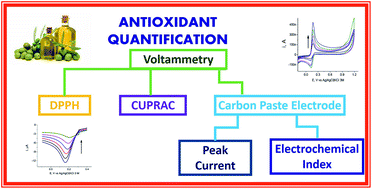Comparison of electrochemical methods using CUPRAC, DPPH, and carbon paste electrodes for the quantification of antioxidants in food oils
Abstract
This work evaluated the feasibility of using electrochemical methods to quantify antioxidants in food oil samples (mainly olive oil). The methods used for analysis were CUPRAC (cupric ion antioxidant capacity), DPPH (2,2-diphenyl-1-picrylhydrazyl), and direct quantification by voltammetry using CPEs (carbon paste electrodes); in the last one, an oil was employed as a binder. Through this study, it was possible to prove that these methodologies are easy to perform and generate reproducible results. The quantification limits were 1.05 × 10−7 M for EI (Electrochemical Index), 3.24 × 10−6 M for DPPH, and 1.09 × 10−4 M in the case of CUPRAC; all the methods had almost the same magnitude of linear range. Also, some differences were found between the obtained results by the studied methods; such differences were attributed to the nature of each chemical probe (proton or electron transfer) for DPPH and CUPRAC and the nature of the electroactive antioxidant molecules present in the sample in the case of CPEs.



 Please wait while we load your content...
Please wait while we load your content...